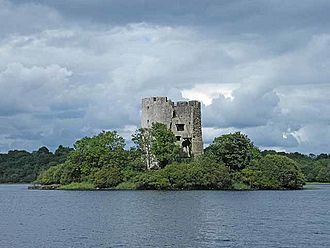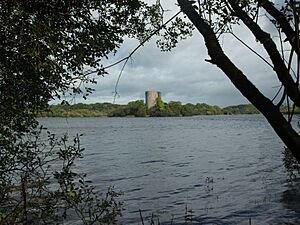Cloughoughter Castle facts for kids
Quick facts for kids Cloughoughter Castle |
|
|---|---|
|
Cloch Locha Uachtair
|
|

Cloughoughter Castle sits on an island in Lough Oughter
|
|
| General information | |
| Location | Lough Oughter, Cavan |
| Country | Ireland |
| Coordinates | 54°01′07″N 7°27′17″W / 54.0187°N 7.4548°W |
| Construction started | 1200 - 1224 |
| Demolished | 1653 |
| Client | William Gorm de Lacy |
| Reference #: | 602 |
Cloughoughter Castle (which means stone castle of Loch Uachtair in Irish) is a cool old circular castle that's now a ruin. It sits on a tiny island in Lough Oughter. This lake is about 4 kilometers (2.5 miles) east of Killeshandra town in County Cavan, Ireland.
Contents
Discovering Cloughoughter Castle
Cloughoughter Castle is a famous landmark in County Cavan. It's known for its unique round shape and its amazing location on an island. This castle has seen a lot of history unfold over many centuries.
A Look Back in Time: Early Days
The castle is located in an area once known as the Kingdom of Breifne. This part later became County Cavan. The island where the castle stands might have been a crannóg. A crannóg is a special type of man-made island built in lakes. Some historians think there might have been a fort here as early as the 500s.
In the late 1100s, the O'Rourke family owned this spot. But by the early 1200s, it seems the Anglo-Norman de Lacy family took control. Experts believe construction of the castle started around this time. The lower two floors of the castle show building styles from the early 13th century.
In 1233, the O'Reilly clan took over the area. They finished building the castle. The O'Reillys kept the castle for hundreds of years. They often had conflicts with the O'Rourkes and even with other parts of their own clan. The castle was sometimes used as a prison. For example, Philip O'Reilly was held there in the 1360s.
The Castle After 1610
After 1610, big changes happened in Ireland. Land was taken and given to new settlers during a time called the Plantation of Ulster. Cloughoughter Castle was given to Captain Hugh Culme. He didn't live in the castle. Instead, he built a new home nearby on the lake shore.
In 1641, Philip O'Reilly, a leader in the Irish Rebellion of 1641, took control of the castle. He held it until 1653. During this time, the castle was used as a jail. Captain Culme himself became a prisoner there. Another famous prisoner was William Bedell, a bishop. He sadly passed away in February 1642, likely due to the cold winter conditions.
In 1649, Owen Roe O'Neill, a commander of the Ulster Army, died at the castle. In March 1653, forces from the Commonwealth of England attacked the castle. These forces were led by Sir Theophilus Jones. Cloughoughter Castle was one of the last places to surrender. It gave up on April 27th.
Sir Theophilus Jones set up his cannons in a nearby area called Innishconnell. The damage from these cannon shots can still be seen on the castle today. After the attack, the castle was left in ruins.
A Beautiful Ruin
Even as a ruin, Cloughoughter Castle became a popular subject for artists in the 1700s and 1800s. People loved its look. One description from 1852 said it was a "beautiful ruin." It was described as round, strong, and covered in green ivy. The walls were very thick. It was also noted that it was different from most Irish castles, which were usually square.
Protecting the Castle Today
Work to protect and preserve the castle began in 1987. Cloughoughter Castle is now a protected site under the National Monuments Act. This means it's an important historical place that is looked after for future generations.


